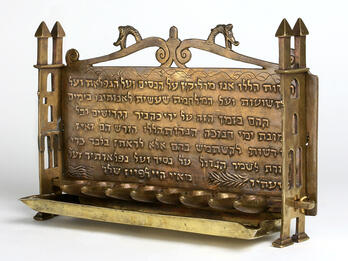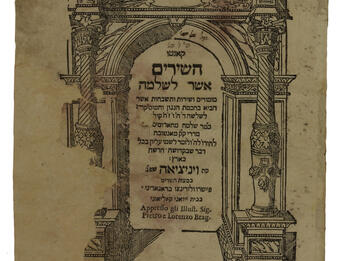Elim: Ma‛ayan ḥatum (Elim: A Sealed Spring)
44
You asked how an object can move without being touched, and this indeed is a puzzling matter to all sages. To explain this issue, I must first discuss some rudiments of the science of music, for if there is only a little written in the Holy Tongue on each field of science, concerning this topic there is written neither a lot nor a little. Now you should know that one thing that makes learning difficult is that teachers do not explain matter from their origins, which, I swear, would be greatly enlightening. Rather, they offer already prepared, prepackaged subjects, and thus the students do not understand what they are receiving. Instead, I will provide you with two accounts of the origins of music.
The first is that, as related in the Holy Scriptures, Tubal-cain was already an expert in the science of music.1 However, after he and his disciples were washed away in the flood, this science was forgotten, until Pythagoras the Greek resurrected it from the dust. It is related about him that he made great efforts and yet was unable to enter the chambers of this wisdom. For he perceived that when loud and sharp noises were combined into a single sound, i.e., when different sounds came together in harmony, it sounded wonderful to the ear. This is the definition of composed music, as can be inferred from Boethius in Ma’amar eḥad, chapter 3, on music.2 Conversely, when the sounds do not harmonize and they ring like separate noises, this is painful and upsets the ear. However, he was unable to discern the reason for this, and although he spent many hours investigating the matter, he failed to explain it. Then one day he happened to enter a blacksmith’s shop where he observed five men striking a single anvil with their hammers, and he noticed that when some of them struck together they produced a pleasant sound. After experimenting with them striking in two sets of pairs—while dismissing the fifth as incorrect or superfluous—he weighed the implements of the four men and found that the first weighed 12 libra, the second 9, the third 8, and the fourth 6. It then became clear that according to the science of numbers, as I have written in the book [Elim:] ḥukot shamayim (Elim: Laws of Heaven), the four numbers could be successfully arranged as pairs only in four combinations, as detailed in the following table:
| A B | A C | A D | B C | B D | C D |
| 12 9 | 12 8 | 12 6 | 9 8 | 9 8 | 8 6 |
You can see that there are in fact only four ratios between the weights of the hammers, for the ratio between A and B is the same as that between C and D, as they are both 3/4, like the ratio between 4 and 3, or 1 and 1/3. Likewise, that ratios of AC and BD are both the same as the ratio between 3 and 2, which is 1 and 1/2. Thus, all the ratios can be whittled down to four, and therefore this number can be called sacred. This is as I wrote in §22, that you will not find any musical proportion other than one of these ratios, or a multiple of these.
Pythagoras proceeded to examine and test this idea with all musical instruments, both percussions and wind, with various types of lyres, fiddles, bells, pipe organs, and cymbals, and he found that they all fit this ratio. He therefore established a general principle that the ratio between the musical instruments themselves will be the same as the ratio between the sounds they produce. In other words, if between one instrument and another, in its weight or length or hollowed space or its wind or whistling, the proportion is double, of 2 to 1; when the two instruments are struck together, they will produce a melodious and pleasing sound to the ear, which is called a diapason [octave]. If their ratio is 4 to 3, the sound they produce is called a diatessaron [fourth]; if the proportion is 3 to 2 it is called a diapente [fifth]; and if it is 9 to 8 it will produce a whole tone [major second]. Once he had become familiar with these sounds, as soon as he heard a tonus pitch from the striking of two hammers he was instantly able to discern that one weighed 9 and the other 8; and the same applied to all of them.
The entire composition of music is based on proportions, and as I have already stated in ḥukot shamayim, the sums of musical intervals are nothing other than multiplications of these ratios, while smaller numbers are found by dividing the ratios. You will not find any division or multiplication of musical intervals where the underlying sum is not, for example, one half, as in the case of a diapason. Thus, if it is a double diapason, e.g., 4/1, when you multiply it by 1/2 you will get 4/2, which is a simple diapason, as the multiplication of 2/1 and 2/1 is 4/1.
Notes
[In the medieval Latin tradition, the story of Pythagoras and the discovery of musical intervals from the forge came to be associated with Tubal[-cain], himself sometimes (mis)identified with Jubal; see Genesis 4:21–22.—Trans.]
[See Boethius, De institutione musica, liber I. Caput X, Quemadmodum Pythagoras proportiones consonantiarum investigaverit.—Trans.]
Credits
Joseph Solomon Delmedigo, Sefer Elim: Ma'ayan ḥatum (Elim: A Sealed Spring) Amsterdam: be-vet Menasheh ben Yisra’el, 1629, no. 44. Republished in: Hebrew writings concerning music, in manuscripts and printed books from Geonic times up to 1800, ed. Israel Adler (München: G. Henle Verlag, 1975),119–120.
Published in: The Posen Library of Jewish Culture and Civilization, vol. 5.





